Key points
- Diffusion is the movement of particles from higher to lower concentrations.
- Diffusion happens naturally and so does not require energy.
- Substances like oxygen, carbon dioxide and glucose move in and out of cells by diffusion.
Video - The role of diffusion in and within cells
If I spray a little perfume over here, before long… I can smell it over here. That's because of a process called diffusion.
Diffusion refers to the overall movement of particles from areas of high concentration to areas of low concentration. In living things, diffusion allows substances to move in and out of cells. It's how red blood cells distribute oxygen through the body.
When empty blood cells enter the lungs, which have an extremely high concentration of oxygen, the molecules pass into the blood cells, filling them up. Now with a high concentration of oxygen, the blood cells flow through parts of the body with a low concentration of oxygen and it diffuses out from the blood cells into those parts. Cells in those parts of the body constantly use oxygen, so it never builds up and always flows in the same direction. The blood cells continue on and empty their oxygen before returning to the lungs for another top up.
Now I'm going to diffuse this perfume out a window.
Can you answer these questions based on the video?
1. How do substances move in and out of cells?
2. Where does oxygen diffuse into the blood?
By diffusion
The lungs
What is diffusion?
Diffusion is the overall movement of any substance from an area of higher concentrationThe number of particles of one substance in a specific volume of another substance. to an area of lower concentration. This can be within a cell or between them. Diffusion only happens in liquids and gases because their particles move randomly from place to place. It is an important process for living things; it is how substances move in and out of cells. It happens naturally and so does not require energy.
The particles collideAnother word for 'bump into'. with each other or with their container. This makes them change direction. Eventually, the particles are spread through the whole container. Diffusion happens on its own, without stirring, shaking or wafting.
Because diffusion is the movement of particles from a higher to lower concentration, we call this down the concentration gradientAnother word for slope..
Diffusion doesn't just happen in cells. Look at the images below to see an example of how coffee particles diffuse in a cup of water.
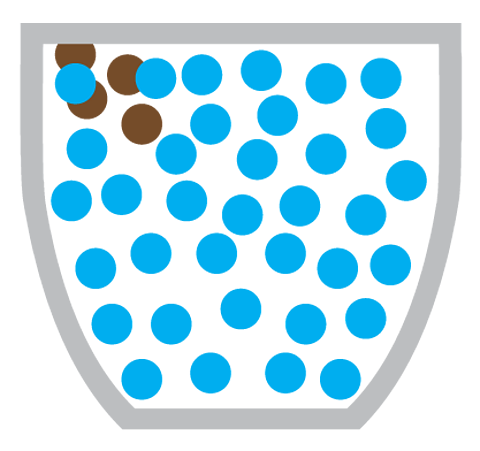
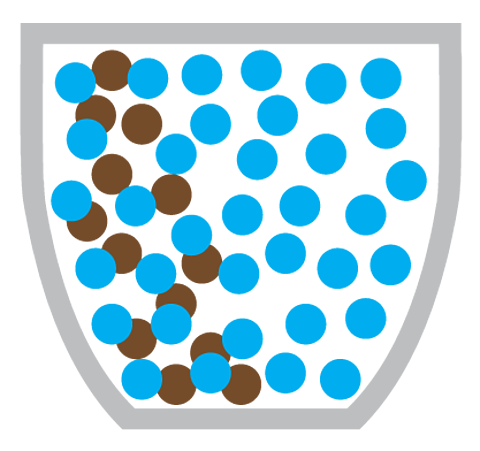
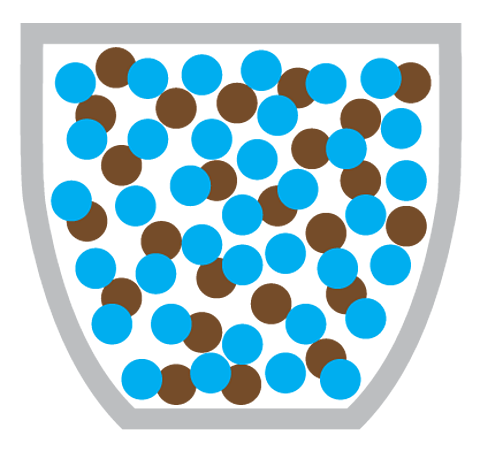
Diffusion of oxygen in the body
Air that is breathed in is around 21% oxygen, while air that is breathed out is only 16%. This means that some of the oxygen from the air has been absorbed into the body when it is breathed into the lungs.
Oxygen is transported to all cells in the body through the following process:
- Oxygen moves by diffusion from an area of higher concentration inside the lungs to an area of lower concentration in the blood. It is then carried away by red blood cells.
- The blood leaving the lungs now has a high concentration of oxygen.
- It travels round the circulatory systemYour heart, blood and blood vessels, including veins, arteries and capillaries to the cells in tissues and organs.
- Here oxygen moves by diffusion from an area of higher concentration in the blood to an area of lower concentration in the cells.
- Cells are always lower in concentration of oxygen than the blood that arrives because the cells use oxygen in respirationA chemical reaction that occurs in the mitochondria of cells in which glucose and oxygen react to produce carbon dioxide and water, releasing energy..
- The blood now has a lower concentration of oxygen because it has diffused into other cells. It returns to the lungs to pick up more oxygen by diffusion and the cycle repeats.
Carbon dioxide is a waste product of respiration and moves by diffusion in the other direction. It moves from the cells into the blood and then from the blood into the lungs before it is breathed out. Unlike oxygen, carbon dioxide is not carried by red blood cells but dissolved in the blood plasmaThe yellow fluid that carries your blood cells, platelets and dissolved substances around your body. .
Diffusion of glucose in the body
As well as oxygen, cells need glucose for respiration. This comes from food. Glucose is transported to all cells in the body by the following process:
- As food is digested, glucose moves by diffusion from an area of higher concentration in the small intestine to an area of lower concentration in the blood.
- The blood leaving the small intestine now has a high concentration of glucose.
- It travels round the circulatory system to the cells in tissues and organs.
- Here glucose moves by diffusion from an area of higher concentration in the blood to an area of lower concentration in the cells.
- Cells are always lower in concentration of glucose than the blood that arrives because the cells use it in respiration.
- The blood now has a lower concentration of glucose because it has diffused into the cells. The blood returns to the small intestines to pick up more glucose by diffusion and the cycle repeats.
Diffusion of water: osmosis
The diffusion of water from an area of higher to lower concentration across a cell membraneA part of a cell - it surrounds the cell and lets substances in and out is called osmosis. The expression 'across a membrane' often means in or out of a cell, which is surrounded by a membrane.
Which substances diffuse where?
| Substance | First movement by diffusion | Second movement by diffusion |
|---|---|---|
| Oxygen | Moves from air breathed in to red blood cells in the lungs | Moves from red blood cells to body cells |
| Carbon dioxide | Moves from body cells to blood plasma | Moves from blood plasma to air breathed out in the lungs |
| Glucose | Moves from small intestine to blood plasma | Moves from blood plasma to body cells |
Test your knowledge
Quiz
Test questions
Write a short paragraph to answer the following question. Tap 'Show answer' to see seven points you could have included.
Starting in the lungs, describe how oxygen moves by diffusion in your body.
- Oxygen moves by diffusion from an area of high concentration in the lungs to an area of lower concentration in the blood. It is then carried away by red blood cells.
- The blood leaving the lungs now has a high concentration of oxygen.
- It travels round the circulatory system to the cells in tissues and organs.
- Here oxygen moves by diffusion from an area of higher concentration in the blood to an area of lower concentration in the cells.
- Cells are always lower in concentration of oxygen than the blood that arrives because cells use oxygen in respiration.
- The blood now has a lower concentration of oxygen because it has diffused into other cells.
- The blood returns to the lungs to pick up more oxygen by diffusion and the cycle repeats.
Starting in the small intestine, describe how glucose moves by diffusion in your body.
- As food is digested, glucose moves by diffusion from an area of higher concentration in the small intestine to an area of lower concentration in the blood.
- The blood leaving the small intestine now has a high concentration of glucose.
- It travels round the circulatory system to the cells in tissues and organs.
- Here glucose moves by diffusion from an area of higher concentration in the blood to an area of lower concentration in the cells.
- Cells are always lower in concentration of glucose than the blood that arrives because the cells use it in respiration.
- The blood now has a lower concentration of glucose because it has diffused into cells.
- The blood returns to the small intestines to pick up more glucose by diffusion and the cycle repeats.
Play the Atomic Labs game! gamePlay the Atomic Labs game!
Try out practical experiments in this KS3 science game.

More on Living organisms
Find out more by working through a topic
- count14 of 15

- count15 of 15
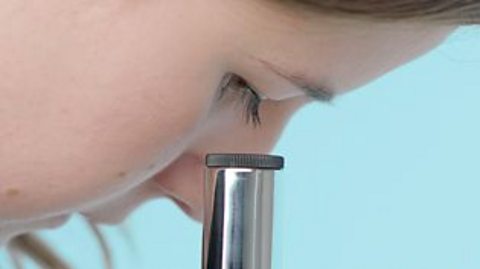
- count1 of 15
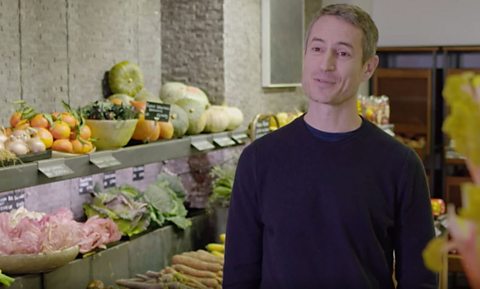
- count2 of 15
